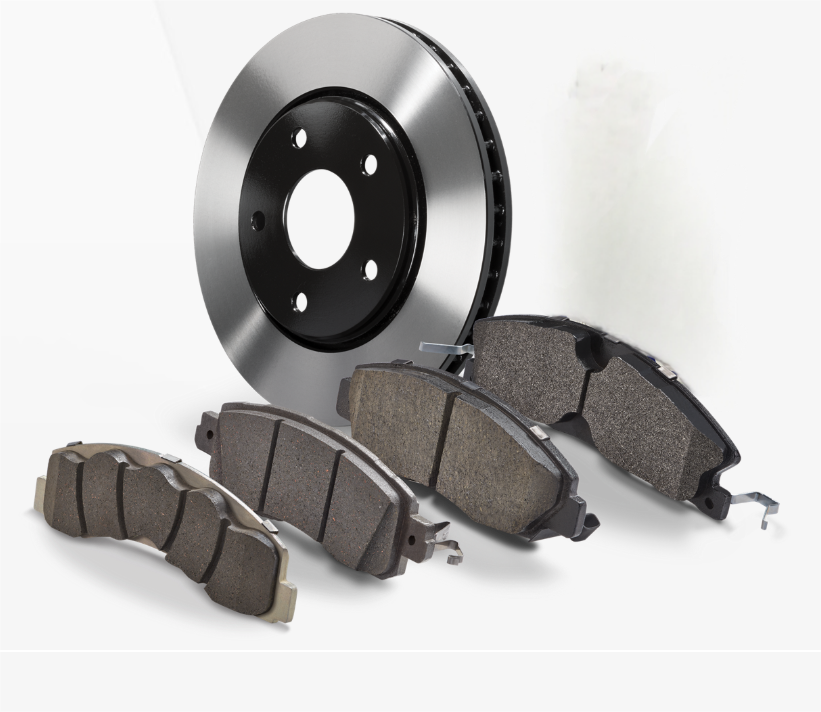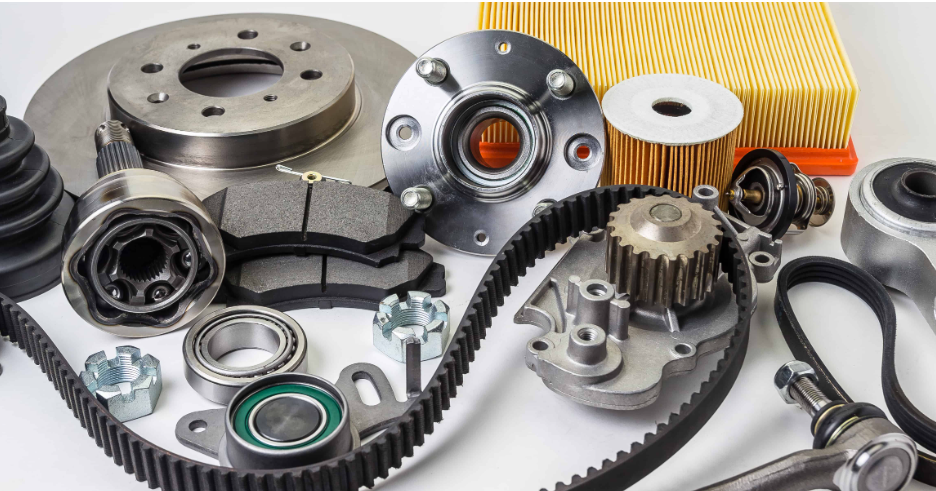Key Features of High-Quality Brake Discs
Thermal Resistance and Heat Dissipation
Having premium brake discs will help to control heat, and that’s what you rely on to avoid brake fade when braking heavily. Ventilated design allow air to circulation under and around the holds and plates to ensure the heat dissipation. Efficient temperature control when braking improves both the safety system and the service life of the brake discs as temperature-related material fatigue is reduced. This emphasizes the value of premium quality brake pads - affordable, effective and essential in maintaining safe and consistent stopping forces under demanding conditions.
Corrosion-Resistant Coatings
Brake discs need to remain in a high level of performance in various environments including rain and snow, and corrosion-resistant coatings are crucial to maintain this. These coatings, such as e-coating and ceramic, serve to prevent rust and corrosion on the disks, helping to extend the life of your brake components. Statistics back that up, arguing that brake discs with those rust prevention coatings can last as much as 50 percent longer in corrosive environments than their uncoated counterparts. That makes them a good option for long-term dependability and stable performance no matter what kind of driving you do.
Precision Engineering for Consistent Performance
Given the importance of the performance of the brakes disc in effective breaking, precise engineering is necessary to accommodate the brake disc to a fit with a braking system. Procedures, for example, use of CNC patterns help maintain stability of performance and stabilizes the vibrations during the brake application. Expert opinion states the importance of precision designed brake discs which can improve stopping distances by 15% also highlighting the importance of developing high performance brake systems with precision engineering. Such improvement not only enhances the safety but also adheres to the growing demand on brake disc replacement and perceives that the requirement of precision is combined together with the demand of real application of automobiles. ## Material Composition and Durability Reading the previous review got me thinking.
G3000 Cast Iron vs. Advanced Alloys
In the brake discs' products, material selection is a significant factor in maximising overall vehicle performance and component life. Classic G3000 cast iron has stood the test of time and is well known for its durability and high temperature performance. But advanced alloys are significantly more beatprocessed, so that in general they are heavier and less agile than advanced light metals, that have been developed to surpass them. These high end alloys have a far better strength to weight ratio which means better acceleration and handling. Compared to conventional vehicles, by employing advanced alloys the vehicle weight can be reduced about 10%, and that is beneficial for fuel economy and vehicle dynamics as a whole.
Impact of Cross-Ground Surface Finish
Powerful braking doesn’t only depend on the materials used, but the surface of the brake discs as well. Cross-ground brake surface finish enables brake pads to tie down to the disc with minimised bed-in time. This finish greatly enhances friction when it comes to, helping to increase the brake response time and reducing brake noise. Vehicle performance testing has shown that cross-ground surfaces can increase initial grip by more than 25%, making this finish critical in high-performance braking. It’s a vital consideration if you are wanting a polished, responsive brake feel.
Longevity in Heavy-Duty Applications
When it comes to high mechanical resistance, like in commercial vehicle and racing, it is necessary to get discs with high resistance power. These applications require such discs to have high flexural strength and to resist micro-cracking and therefore require materials with these properties. Brake disc manufacturers claim that for heavy applications the brake discs should be good for over 60000 miles before they should be replaced. This durablity is very important to any performance enthusiast or fleet owner so you can enjoy your machine without worrying if the driveline is going to hold up when you need it. ##Extreme Conditions Performance
Handling High-Speed Braking Scenarios
Brake discs must perform consistently and predictably (and be light enough) to be propelled hard at high-speed braking. During heavy breaking the brakes can overheat, leading to fade. But high-end discs nowadays also sport perforations, or slots, which dramatically assist cooling. This cooling not only serves to prevent brake overheat but also avoids �fade�, the loss of braking efficiency when hot. Actual performance data across a number of track tests confirm that a properly designed disc is able to maintain performance under extended high-speed use; so drivers can have full confidence in their braking system when the going gets heavy.
Reducing Brake Fade in Trucks and Towing
Such brake fade is a serious problem with respect to trucks, towed vehicles, and the like, where regular operation can cause an increase in temperature of the brake parts resulting in an accompanying loss in application of the brakes. In order to reduce this phenomenon, the successecuill disc shapes employ high thermal mass materials for the discs thereby enhancing the disc heat dissipation without compromising the braking performance. Furthermore, advanced ventilation technology enhances thermal control. The latest figures suggest that brake fade can be up to 40% less in heavy load conditions if you use the best brake discs. These developments are thus intended to make sure that braking function remain effective even under harsh conditions, maximizing safety for heavyweight practice.
Compatibility with High-Performance Brake Pads
These premium high-quality Brake Discs need to be used with high-performance Brake pads for max performance and wear. The combination of the discs and pads should be such as to achieve the optimum friction coefficient for high efficiency braking with minimum wear. Research has also revealed the mismatched components can cause premature wear on both discs and pads reinforcing the need to match parts from an expert when fitting brake systems. As a result, it is critical for vehicle owners and service providers to consider the compatibility of the braking system to ensure optimal brake safety and performance, as well as overall braking wear-and-tear, including brake pad life longevity for a wide range of high-performance and demanding driving conditions. ## Indicators of Brake Disc Wear and Service
How to Check Brake Disc Thickness
Ensure safe and effective braking with the help of your brake disc thickness checker. Brake disc wear is another important aspect to monitor: make it a policy to always have your brake discs within the thickness parameters set by the manufacturer. The best way to measure this is with a pair of calipers. The OEM should give a minimum thickness, and this is the point at which the disc should be replaced. Checking your brake disc thickness at regular intervals can help to avoid these catastrophic failures and maximises the life of both the disc and the brake pad, which is critical for vehicle safety.
Identifying Grooves and Warping
Grooves that are worn must indicate that breaking may not be working efficiently. Evident warping, that can be seen through visual inspection; being felt as a small vibration while braking, is also a sign that you will have to maintain them soon. Left unsolved, these problems can cause dangerous driving conditions and expensive repairs. By properly maintaining the tyres, it is possible to detect grooves and warping early and to take corrective action in a timely manner to remain safe on the road.
Noise Indicators and Vibration Analysis
Uncommon sounds such as squeaking or grinding when breaking are usually a sign of brake disc issues and need to be repaired as soon as possible. Likewise, examining vibrations experienced during braking can lead to challenges such as disc balance (or imbalance) and even cracking — which poses an obvious safety concern. Need For Checking: It is recommended to get a professional technician to help you with diagnostic tests in order to evaluate wear patterns and protect residual life of your brake discs. This preventative approach means that you can prevent excessive wear and tear and maintain your entire braking system in good condition. ## Selecting the Best Brake Discs for Safety
Matching Discs to Vehicle Type (Trucks, EVs, etc.)
To get the right brake discs for your car, you need to first understand what your vehicle actually needs in terms of weight and usage patterns. It is important to remember that trucks require more durable braking discs to manage the additional weight loads. By contrast, lightweight materials are often advantageous for electric vehicles (EVs) to increase driving range. Understanding these differences is necessary when it comes time to choose the best brake discs. Experts in the trade often recommend custom options in order to suit the specific dimensions and requirements of different types of vehicles, providing not just protection but also helping to get the most out of your car.
Balancing Cost and Quality in Replacements
Though it may seem like a cost-effective solution to get cheap brake discs during repairs, it usually a question of these parts being made in short cuts affecting quality and safety for many years to come. Good brake discs are, however, a good investment. They can save you a lot of money by decreasing the necessity of replacement, and preventing damage to other parts of the vehicle. Quality is important – research has shown that by spending just a little more for quality furniture, a saving of up to 33% on overall maintenance costs can be achieved. The quality is better, and even if it is more expensive at the beginning, it has the assurance of being reliable and foolproof.
Importance of OEM Standards and Certifications
Matching the brake discs to an Original Equipment Manufacturer (OEM) specification is essential to ensure performance and reliability. OEM approval guarantees that the brake discs have been subjected to extensive testing and produce a real benchmark for quality and performance of discs for the automotive aftermarket, enhancing safety and peace of mind. Research shows that cars with OEM certified parts have far fewer problems during their life than those without the certification. With the certified quality to back it, certified parts are the right choice for keeping your vehicle in top shape for as long as you own it.
Table of Contents
-
Key Features of High-Quality Brake Discs
- Thermal Resistance and Heat Dissipation
- Corrosion-Resistant Coatings
- Precision Engineering for Consistent Performance
- G3000 Cast Iron vs. Advanced Alloys
- Impact of Cross-Ground Surface Finish
- Longevity in Heavy-Duty Applications
- Handling High-Speed Braking Scenarios
- Reducing Brake Fade in Trucks and Towing
- Compatibility with High-Performance Brake Pads
- How to Check Brake Disc Thickness
- Identifying Grooves and Warping
- Noise Indicators and Vibration Analysis
- Matching Discs to Vehicle Type (Trucks, EVs, etc.)
- Balancing Cost and Quality in Replacements
- Importance of OEM Standards and Certifications







